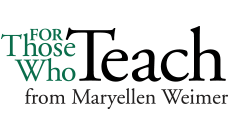Three articles in the February issue of the Teaching Professor newsletter deal with peer learning—a large category that includes activities through which students learn from and with each other. Peer learning gets troublesome for many faculty due to the idea that students are teaching each other. Isn’t that our job? Students aren’t paying all those tuition dollars to learn from other students and they aren’t shy about saying as much. Students are paying to be taught by experts. If we’re not the ones teaching, we sometimes feel guilty.
 Beyond professional obligations and feelings are worries as to what and how students are learning from each other. They don’t have content expertise, which makes it highly likely that they are teaching content at a superficial level. Chances are also good that students are teaching and learning some of the content incorrectly.
Beyond professional obligations and feelings are worries as to what and how students are learning from each other. They don’t have content expertise, which makes it highly likely that they are teaching content at a superficial level. Chances are also good that students are teaching and learning some of the content incorrectly.
What stands alongside those concerns is all sorts of evidence documenting that students can and do learn from and with each other. It’s something they seem to understand intuitively, if not explicitly. When students have a question about something that’s happening in a course, who do they ask first? Most of the time, it’s not the professor. They talk to another student who answers the question, offers advice, shares information, or registers an opinion. That dynamic means that students are regularly learning from other students.
So, we must start by accepting that peer learning is not something easily preventable, but is it something we should cultivate? What does peer learning have going for it that’s missing from the instruction teachers provide? For starters, peers speak each other’s language. No, it’s not academic discourse; it’s often not articulate or erudite. But it is a language and a perspective that makes sense to students, which can help novices gain a foothold toward understanding. We can’t always say the same for the language academics use.
Then there’s the advantage that comes with just having learned something. What accompanies recent learning experiences are memories of what led to the understanding—the example that helped, the problem that made it clear, the part of the text that explained it well, or the way another student described it. If what you’re trying to explain is something you learned 20 years ago, chances are good your memory of what it looked like when you first encountered it is unclear. “It’s easy,” says the professor who can’t understand why the student doesn’t get it. But to the student struggling to understand, it’s not easy; another student may have more empathy and a way to explain it that perhaps wouldn’t occur to the professor.
In addition, students feel safer going to a peer than to the professor. Peers are equals, fellow learners. Professors know so much more that it can be intimidating. Who wants to look stupid, confused, or unable to understand something in front of the professor? What if the professor remembers the encounter when giving out grades? If students go to another student, he or she may not know the answer, but at least there is no risk of looking stupid or having it affect your grade.
So, peers have some teaching advantages unavailable to teachers. But what if a student passes along wrong information or teaches the content incorrectly? The reality of that happening rounds us back to the need for teachers and students to think differently about mistakes—seeing them as opportunities for learning, more powerful than first landing on the correct answer. Yes, mistakes can be costly, but they aren’t as costly in college as they will be on the job and in life. Moreover, courses have teachers present to ensure that the correct answer is part of what’s learned from making the mistake.
Peer learning is an instructional strategy, one approach among many available to teachers. No one is advocating that peer learning replaces the teacher. Students still need teachers, and teachers still need to teach. As with all instructional strategies, peer learning works when it’s selected purposefully, when its use is planned carefully, and when the learning it promotes is evaluated. How teachers design assignments, how they structure the activities in which students work together, and how they use the criteria to assess peer learning all create the context in which peer learning occurs. Those parameters direct both what is learned and how it’s learned. The design and management of learning experiences is not a diminished role or one about which teachers need to feel guilty. It requires sophisticated teaching expertise.
© Magna Publications. All rights reserved.






